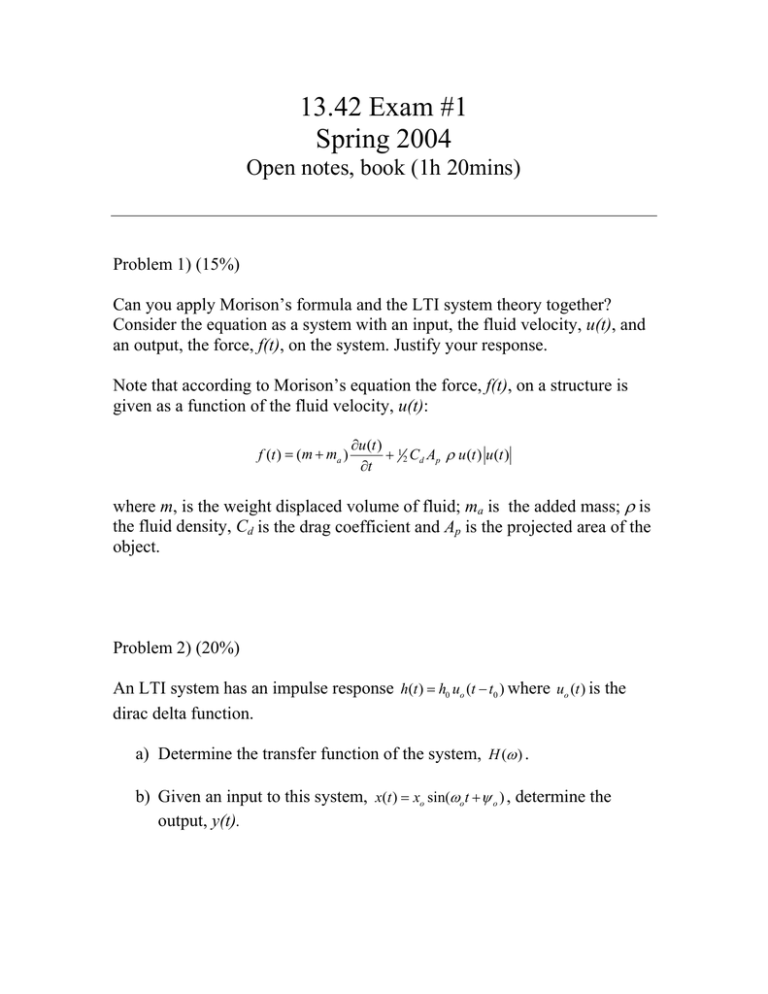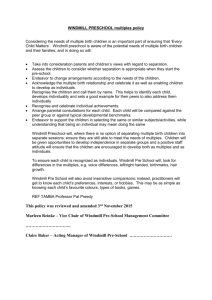13.42 Exam #1 Spring 2004 Open notes, book (1h 20mins) ρ
advertisement

13.42 Exam #1 Spring 2004 Open notes, book (1h 20mins) Problem 1) (15%) Can you apply Morison’s formula and the LTI system theory together? Consider the equation as a system with an input, the fluid velocity, u(t), and an output, the force, f(t), on the system. Justify your response. Note that according to Morison’s equation the force, f(t), on a structure is given as a function of the fluid velocity, u(t): f (t ) = (m + ma ) ∂u (t ) 1 + 2 Cd Ap ρ u (t ) u (t ) ∂t where m, is the weight displaced volume of fluid; ma is the added mass; ρ is the fluid density, Cd is the drag coefficient and Ap is the projected area of the object. Problem 2) (20%) An LTI system has an impulse response h(t ) = h0 uo (t − t0 ) where uo (t ) is the dirac delta function. a) Determine the transfer function of the system, H (ω ) . b) Given an input to this system, x(t ) = xo sin(ωot +ψ o ) , determine the output, y(t). Problem 3) (30%) (See figure at left on pg 4) An offshore windmill is mounted on a cylindrical spar buoy with diameter, d, and depth below the free surface, H, which is moored in deep water. The incident waves have wavelength much greater than the spar buoy diameter, thus no wave diffraction occurs at the structure. Monochromatic, incident waves propagate from left to right with frequency, ω = 1.2 rad/s. (see figure on page 4) a) Sketch the particle orbits under the waves at the location of the windmill. b) Give the total pressure, as a function of time and depth, acting horizontally along the centerline of the spar platform. c) Model the motion of this buoy in surge (x1) as a linear system, neglecting the effects of the windmill on the system dynamics and assuming the system moves purely in surge. Note: The restoring force results from the mooring cables and the restoring coefficient is C11 = [Tension]/[Cable Length] (Newton/meter). The damping can be modeled as linear with coefficient, B11 (kg/second), and the system mass is m (kg) . The input to the system is the horizontal wave force, f1(t), resulting from the dynamic pressure under the wave acting on the buoy. The system output is the surge motion, x1(t). d) Determine the transfer function of this system in surge (x1-direction), again neglecting the effects of the windmill on the system dynamics. Problem 4) (35%) (See figure at right on page 4) Since the floating windmill is very complex to design, you are asked to design an offshore windmill platform that is fixed to the sea floor. One of the major design concerns is to ensure that the platform is tall enough so that the tips of the blades do not get wet on a regular basis (i.e. We do not want the blades to cut through the water when the waves are higher than some level ho more than so many times per day or per hour on average.) a) What information do you need to know about the seas in this region to determine an ideal design height for this platform? (In an ideal world where you can have all the data you need.) b) If the predominate wind speed in that region is 4 m/s what is the limiting wave frequency? (assuming deep water) c) Given the wave amplitude spectrum below for the waves in this region, determine the significant wave height, ζ. (note: for the purpose of this problem this spectrum can be considered narrow banded) 30 25 S +( ω ) 20 ω 15 10 5 0 0 0.5 1 1.5 Frequency (rad/sec) (Prob. 4 is con’t on next page) 2 (rad/s) 0.5 1.0 1.5 2.0 dω = 0.5 rad/s S+(ω) m /(rad/s) 12 24 18 6 2 (Problem 4 Continued) d) Determine the height above which the blades would swipe through the water less than 3 times per day (on average). e) Is it sufficient to design the windmill so that the blades just barely skip the waves? Do you estimate that this would be an efficient design in general? Explain briefly. Floating Windmill design Problem 3 Fixed Windmill Design Problem 4




